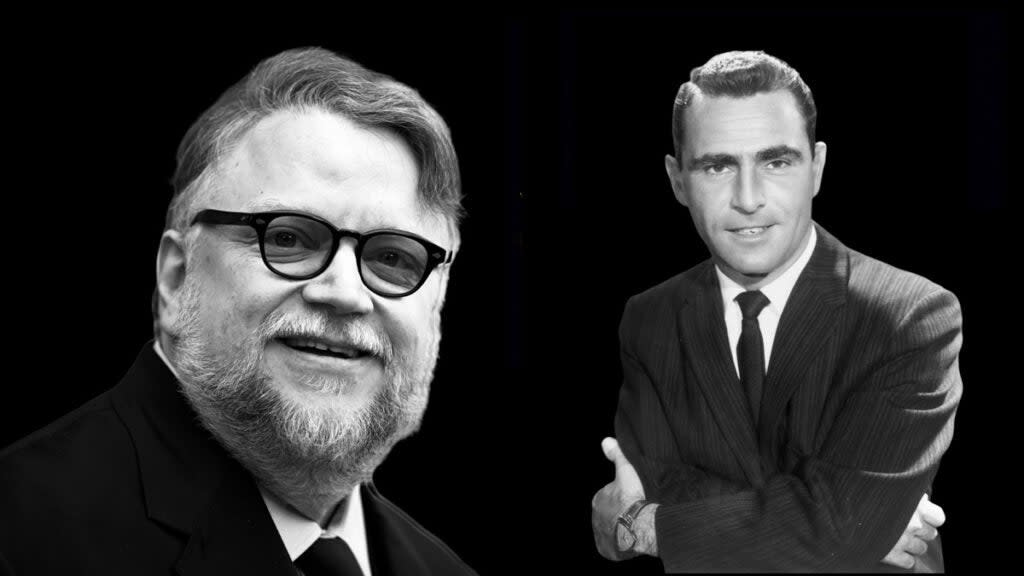Why ‘Cabinet of Curiosities’ Is Guillermo del Toro’s Love Letter to Rod Serling’s ‘Night Gallery’

- Oops!Something went wrong.Please try again later.
- Oops!Something went wrong.Please try again later.
When Guillermo del Toro walks out of the darkness to introduce his “Cabinet of Curiosities,” he’s also walking directly out of the year 1969.
The eight-episode horror anthology has been in Netflix’s top 10 since its release Oct. 25. Each beautifully crafted episode begins with creator and host del Toro pulling an objet d’art from his elaborate cabinet to introduce the tale and its director, as well as a chess-piece-sized carving of each director.
In a tweet, del Toro explained some of the inspiration of his Cabinet: “First night: EC vibes,” he wrote, referring to the massively influential EC horror comics of the ‘50s such as Tales from the Crypt and The Vault of Horror. “Second night: unsettling and ‘now’, Third night: period/pulp classics and Final night: voices that, in my estimation, are clear and loud in the symphony of our genre.”
But del Toro goes much deeper in his introduction to the upcoming, newly-expanded edition of Scott Skelton and Jim Benson’s indispensable “Rod Serling’s Night Gallery: An After-Hours Tour” (Creature Features). We got an early look at the volume, due out in December. If del Toro’s Cabinet intros remind you of that legendary 1969-1973 horror anthology show, it’s no accident. In the series that came a few years after “The Twilight Zone,” Serling strolled out of the shadows in much the same way, to introduce a painting for each story. del Toro recalls,
As a young boy, I would watch “Night Gallery” very late at night in my grandmother’s house, after everybody went to bed. I have incredibly vivid memories of the series, of the fear that enveloped me when I watched each episode: the fantastic opening featuring those wide-angle faces, distorted and grimacing; Gil Mellé’s incredible music that created feelings of both fear and excitement; and Rod Serling’s carefully phrased introductions of Tom Wright’s horrific and dread-filled paintings that haunt my imagination to this day.
“Night Gallery” left an indelible impression on del Toro, even more so than what he acknowledges was the more artistically accomplished “Twilight Zone.” Serling was infamously frustrated by the fact that he had less creative control over “Night Gallery,” and the result was a series that remains beloved but considered far more hit-and-miss in quality. Still, del Toro writes that he prefers it, “because it occupies itself with touching and poetic musings about darker subjects.”
He lists “The Messiah on Mott Street” as one of his favorite stories. Directed by Don Taylor from a teleplay by Serling, the especially poignant tale features a boy (Ricky Powell) trying to help his bedridden Jewish grandfather (Edward G. Robinson) during the holiday season, and brings home a mysterious black man (Yaphet Kotto) whom he’s convinced can help. The story was personal to del Toro, who spent many seasons with his frail grandmother while his parents were away. You can also see some “Mott Street” DNA in del Toro’s first film, “Cronos,” from 1993, about a little girl and her vampire grandfather.
“Night Gallery’s” near-legendary shocker, “The Caterpillar,” also left a strong impression on young del Toro. You may also know this one a the creepy earwig episode. In one of his final roles, Laurence Harvey plays a sweaty sleaze-bag in the Malayan jungle who wants a colleague’s wife (Joanna Pettet) and plots to get rid of the other man in a nightmarish fashion: have an earwig dropped in the man’s ear so it’ll tunnel into his brain and cause an excruciating, lingering death.
In “After Hours,” del Toro laments that Serling may not have been as praised as such contemporaries of his as Paddy Chayefsky (“Network”) and Reginal Rose (“12 Angry Men”), but Serling’s the one who shaped his own sensibilities far more. He writes that, “in my heart, his stories for ‘Night Gallery’ are among the most important influences in my creative life and the way I view the world.”
Del Toro has been doing something else Serling did: helping pull horror and fantasy into the mainstream, even if he isn’t so much using them as Trojan Horses for social commentary. While much horror can be lower-budget affairs that are critic-proof but still turn a profit, del Toro’s work from “Cronos” to “Cabinet” is known for its sumptuous look, and critics have generally adored him – with his 2017 “Creature from the Black Lagoon” homage, “The Shape of Water,” winning four Oscars including Best Director and Best Picture.
And like Lucas, Spielberg and Tarantino, del Toro has made a career of taking a once ghettoized genre he loves, distilling the best from it, and serving it up to new audiences with a polish the originals seldom had. As much as anyone may love “Night Gallery,” its budget limitations could range from cheap to comically cheap in some tales further down the food chain from the artistic high point of “The Caterpillar.” See, for instance the supposedly giant mouse on the moon in “The Nature of the Enemy.” Let’s just say the huge subterranean rodent in the “Graveyard Rats” episode of Cabinet is a significant upgrade.
“Cabinet of Curiosities” is del Toro coming full circle with his childhood inspiration and its own creator and host. As he writes in “After Hours,” “Every week, at the end of the program, I would turn the TV off and ascend the stairs to my bed in my grandmother’s house, and I felt both scared and moved in equal measure. Serling advocated for humanity with his gallery of horror—as, I hope, do I.”
Comments from del Toro are featured in two other episodes in the “Night Gallery” Season 3 Blu-ray set coming from Kino Lorber on November 22: “Rare Objects” and “Finnegan’s Flight.”
Also Read:
‘Guillermo del Toro’s Pinocchio’ Debuts to Glowing Reviews: Director’s ‘Best Movie in a Decade’

